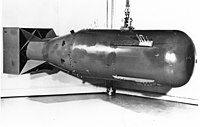
Photo from wikipedia
Black carbon (BC) exerts a large impact on climate radiative forcing and public health, and such impacts depend strongly on chemical composition and mixing state. Here a single particle aerosol… Click to show full abstract
Black carbon (BC) exerts a large impact on climate radiative forcing and public health, and such impacts depend strongly on chemical composition and mixing state. Here a single particle aerosol mass spectrometry (SPA-MS) along with an aerosol chemical speciation monitor was employed to characterize the composition and mixing state of BC-containing particles in summer and winter in Beijing. Approximately 2 million BC-containing particles were chemically analyzed, and the particles were classified into nine and eight different types in summer and winter, respectively, according to mass spectral signatures and composition. The BC-containing particles in summer were dominated by the type of nitrate-related BC (BC-N, 56.7%), while in winter the BC mixed with organic carbon (OC) and sulfate (BCOC-S), and OC and nitrate (BCOC-N) were two dominant types accounting for 44.9% and 16.6%, respectively. The number fractions of BC-N in summer, and BCOC-N and BC-SN in winter increased largely during periods with severe air pollution, suggesting the enhanced secondary formation on BC-containing particles. We also found that the primary emissions of the biomass burning and coal combustion can affect BC mixing state substaintially as indicated by the considerable fraction of BC mixed with levoglucosan and polycyclic aromatic hydrocarbons in winter. Bivariate polar plots and back trajectory analysis indicated that the sulfate-associated BC-containing particles were mostly from regional transport while the nitrate-related type was more from local production. The optical parameter of absorbing Ångström exponents (AAE) of BC was 1.2 and 1.5 in summer and winter, respectively, and the AAE dependence of BC mixing state was also different in the two seasons. While higher fractions of BC-N were observed during lower AAE periods in summer, the variations of dominant OC-related BC-containing particles in winter were fairly stable as a function of AAE.
Journal Title: Environmental pollution
Year Published: 2020
Link to full text (if available)
Share on Social Media: Sign Up to like & get
recommendations!